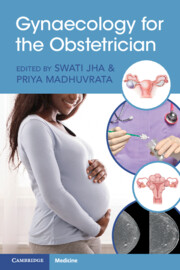Book contents
- Gynaecology for the Obstetrician
- Gynaecology for the Obstetrician
- Copyright page
- Dedication
- Contents
- Contributors
- Foreword
- Preface
- Chapter 1 Ovarian Cysts in Pregnancy
- Chapter 2 Fibroids in Pregnancy
- Chapter 3 Cervical Abnormalities in Pregnancy
- Chapter 4 Vulval Disorders in Pregnancy
- Chapter 5 Congenital Uterine Malformations and Vaginal Anomalies
- Chapter 6 Vaginal Prolapse and Previous Prolapse Surgery
- Chapter 7 Urinary Tract Problems in Pregnancy
- Chapter 8 Previous Third and Fourth Degree Tears
- Chapter 9 Management of Post-Partum Retained Placental Remnants
- Chapter 10 Gestational Trophoblastic Disease (GTD)
- Chapter 11 Female Genital Mutilation
- Chapter 12 Ovarian and Cervical Malignancy in Pregnancy
- Chapter 13 Post-Partum Contraception
- Chapter 14 Pregnancy Associated Breast Cancer
- Index
- References
Chapter 6 - Vaginal Prolapse and Previous Prolapse Surgery
Published online by Cambridge University Press: 14 July 2023
- Gynaecology for the Obstetrician
- Gynaecology for the Obstetrician
- Copyright page
- Dedication
- Contents
- Contributors
- Foreword
- Preface
- Chapter 1 Ovarian Cysts in Pregnancy
- Chapter 2 Fibroids in Pregnancy
- Chapter 3 Cervical Abnormalities in Pregnancy
- Chapter 4 Vulval Disorders in Pregnancy
- Chapter 5 Congenital Uterine Malformations and Vaginal Anomalies
- Chapter 6 Vaginal Prolapse and Previous Prolapse Surgery
- Chapter 7 Urinary Tract Problems in Pregnancy
- Chapter 8 Previous Third and Fourth Degree Tears
- Chapter 9 Management of Post-Partum Retained Placental Remnants
- Chapter 10 Gestational Trophoblastic Disease (GTD)
- Chapter 11 Female Genital Mutilation
- Chapter 12 Ovarian and Cervical Malignancy in Pregnancy
- Chapter 13 Post-Partum Contraception
- Chapter 14 Pregnancy Associated Breast Cancer
- Index
- References
Summary
Pelvic organ prolapse is a common gynaecological problem and often requires surgical management. It is therefore inevitable that vaginal prolapse will also be encountered in pregnancy. Antepartum prolapse is managed conservatively with pessaries and physiotherapy, though occasionally more active surgical intervention will be required. Intrapartum complications in women going into labour with a prolapse are uncommon, however may occur and the commonest problems encountered are cervical dystocia and cervical lacerations. Mode of delivery remains controversial. Women usually have a recurrence of prolapse post-natally and treatment needs to be tailored to patient preferences.
- Type
- Chapter
- Information
- Gynaecology for the Obstetrician , pp. 50 - 60Publisher: Cambridge University PressPrint publication year: 2023



